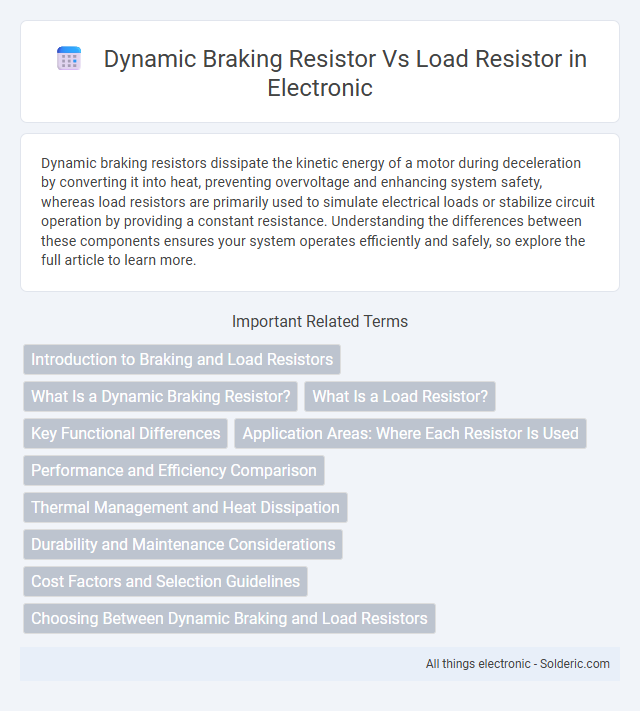Dynamic braking resistors dissipate the kinetic energy of a motor during deceleration by converting it into heat, preventing overvoltage and enhancing system safety, whereas load resistors are primarily used to simulate electrical loads or stabilize circuit operation by providing a constant resistance. Understanding the differences between these components ensures your system operates efficiently and safely, so explore the full article to learn more.
Comparison Table
| Feature | Dynamic Braking Resistor | Load Resistor |
|---|---|---|
| Purpose | Dissipates excess electrical energy as heat during motor braking | Limits current and stabilizes voltage in circuits |
| Application | Used in variable frequency drives (VFDs) and electric trains for safe deceleration | Common in power supply circuits and electronic devices as a passive load |
| Power Rating | High power rating to handle braking energy | Varies; generally lower power rating compared to dynamic braking resistors |
| Heat Dissipation | Designed for continuous high heat dissipation | Handles heat generated by current flow, typically less intense |
| Type of Load | Transient load activated during braking | Steady-state load in circuits |
| Installation | Integrated with motor control systems or traction equipment | Used in circuit design for current limiting or load simulation |
Introduction to Braking and Load Resistors
Braking resistors are used in electric drives to dissipate energy generated during deceleration, converting kinetic energy into heat to protect the system from overvoltage. Load resistors, on the other hand, provide a controlled load to stabilize voltage and current in electrical circuits under varying operational conditions. Both components are essential for ensuring safe and efficient operation by managing excess energy and maintaining system stability in industrial applications.
What Is a Dynamic Braking Resistor?
A dynamic braking resistor dissipates the excess electrical energy generated during the deceleration of electric motors, converting it into heat to prevent damage to the drive system. Unlike load resistors, which primarily manage continuous power loads, dynamic braking resistors are specifically designed for short-term, high-energy dissipation during braking phases. Your motor control setup benefits from dynamic braking resistors by enhancing safety and improving motor longevity during rapid deceleration.
What Is a Load Resistor?
A load resistor is an electrical component designed to dissipate energy by converting electrical power into heat, effectively managing excess current in circuits. It plays a crucial role in protecting equipment by ensuring the current flow remains within safe limits, preventing damage. Your choice between a load resistor and a dynamic braking resistor depends on whether you need constant energy dissipation or controlled braking in motor applications.
Key Functional Differences
Dynamic braking resistors convert excess kinetic energy into heat to safely slow down electric motors, while load resistors primarily manage current flow and voltage levels within circuits. Dynamic braking resistors are designed to handle high power dissipation during motor deceleration, whereas load resistors maintain stable operating conditions under normal load. Your choice depends on whether you need to control motor speed or regulate electrical parameters.
Application Areas: Where Each Resistor Is Used
Dynamic braking resistors are primarily used in electric traction systems, cranes, and elevators to safely dissipate excess energy generated during regenerative braking, preventing damage to the system. Load resistors find application in power supplies, testing equipment, and electronic circuits to simulate loads, balance currents, or stabilize voltage levels under various operating conditions. Both types of resistors are critical for managing energy and ensuring operational reliability in industrial and transportation sectors.
Performance and Efficiency Comparison
Dynamic braking resistors offer superior energy dissipation efficiency by converting kinetic energy into heat during motor deceleration, reducing wear on mechanical brakes and improving overall system performance. Load resistors, while simpler, often dissipate continuous power and may result in higher energy losses and less precise control during braking phases. The dynamic braking resistor's adaptive response enhances energy efficiency and system reliability compared to the static nature of load resistors.
Thermal Management and Heat Dissipation
Dynamic braking resistors provide efficient thermal management by converting excess electrical energy into heat, which is dissipated through specialized resistor surfaces designed to withstand high temperatures. Load resistors primarily manage heat generated during continuous current flow but typically lack the enhanced heat dissipation capabilities found in dynamic braking resistors, which are optimized for intermittent peak energy absorption. Your system's thermal performance improves significantly with dynamic braking resistors due to their superior heat dissipation design and thermal stability under high-load conditions.
Durability and Maintenance Considerations
Dynamic braking resistors offer superior durability due to their design for high energy dissipation during motor deceleration, resulting in less frequent replacement compared to load resistors. Load resistors, while simpler, typically experience higher thermal stress and wear, requiring more regular maintenance and monitoring to prevent failure. Choosing dynamic braking resistors can reduce your maintenance efforts and improve system reliability over time.
Cost Factors and Selection Guidelines
Dynamic braking resistors typically incur higher upfront costs due to their specialized thermal management and precise resistance materials but offer greater efficiency in dissipating braking energy. Load resistors are generally less expensive and simpler, suitable for steady-state applications with lower power dissipation requirements. Selection guidelines emphasize matching resistor power ratings and thermal resistance to the specific application load and braking duration to ensure optimal performance and cost-effectiveness.
Choosing Between Dynamic Braking and Load Resistors
Choosing between dynamic braking resistors and load resistors depends on your system's energy dissipation needs and efficiency requirements. Dynamic braking resistors convert kinetic energy into heat during motor deceleration, offering rapid and controlled stopping without affecting the power supply. Load resistors, by contrast, primarily serve as a continuous load to stabilize circuits or dissipate excess energy but lack the active braking capability dynamic resistors provide.
Dynamic braking resistor vs load resistor Infographic

 solderic.com
solderic.com